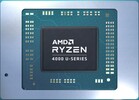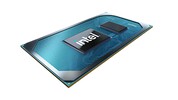AMD Ryzen 5 PRO 4650U vs Intel Core i5-11300H
AMD Ryzen 5 PRO 4650U
► remove from comparison
The AMD Ryzen 5 PRO 4650U is a processor for thin and light laptops based on the Renoir architecture. The 4650U integrates six cores based on the Zen 2 microarchitecture. They are clocked at 2.1 (guaranteed base clock) to 4 GHz (Turbo) with SMT for a total of 12 threads. The chip is manufactured on the modern 7 nm TSMC process and partly thanks to it AMD advertises a 2x improved performance per Watt for the Renoir chips.
The PRO processors offer a range of business features like hardware security (e.g., AMD Memory Guard), manageability (e.g., support for Microsoft Endpoint Manager), and longer availability and software stability.
In addition to the six CPU cores, the APU also integrates a Radeon RX Vega 6 integrated graphics adapter with 6 CUs at up to 1500 MHz. The dual channel memory controller supports DDR4-3200 and energy efficient LPDDR4-4266 RAM. Furthermore, 8 MB level 3 cache can be found on the chip. See our hub page on the Renoir Processors for more information.
Performance
The average 4650U in our database is just as fast as the Intel Core i7-11375H and the AMD Ryzen 5 4600U are in multi-thread workloads. This is a fairly decent mid-range CPU, as of late 2021.
Your mileage may vary depending on how high the CPU power limits are and how competent the cooling solution of your system is.
Power consumption
This Ryzen 5 series chip has a default TDP (also known as the long-term power limit) of 15 W. Which is a tad too high to allow for passively cooled designs, besides, laptop makers aren't really obliged to stick to it.
The AMD Ryzen 5 PRO 4650U is manufactured on TSMC's 7 nm process, leading to average, as of mid 2023, energy efficiency.
Intel Core i5-11300H
► remove from comparison
The Intel Core i5-11300H is a mid range SoC for thin and light gaming laptops and mobile workstations. It is based on the Tiger Lake H35 generation and was announced early 2021. It integrates four Willow Cove processor cores (8 threads thanks to Hyper-Threading). The base clock speed depends on the TDP setting and can vary from 2.6 (28 W TDP) to 3.1 GHz (35 W). The boost of a single and two cores under load can reach up to 4.4 GHz. All four cores can reach up to 4 GHz. The L3 cache is reduced to 8 MB compared to the 12 MB of the higher end i7 models.
The SoC also has the improved Xe graphics adapter with 80 CUs running at up to 1,300 MHz.
Furthermore, Tiger Lake SoCs add PCIe 4 support (four lanes), AI hardware acceleration, and the partial integration of Thunderbolt 4/USB 4 and Wi-Fi 6 in the chip.
All articles on Tiger Lake can be found on our Tiger Lake architecture hub.
Performance
The average 11300H in our database proves to be an OK lower mid-range CPU, as of early 2022, its multi-thread benchmark scores nearly matching those of the AMD Ryzen 3 5300U. The Core i5 will handle most day-to-day activities with ease, only sweating at the sight of latest triple-A games and similar tasks.
Thanks to its decent cooling solution and a long-term CPU power limit of 40 W, the Nitro 5 AN517-53 is among the fastest laptops built around the 11300H that we know of. It can be around 50% faster in CPU-bound workloads than the slowest system featuring the same chip in our database, as of August 2023.
Power consumption
This Core i5 series chip has a default TDP of 28 W to 35 W, the expectation being that laptop makers will go for a higher value in exchange for higher performance. Either way, these values are way too high to allow for passively cooled designs.
The i5-11300H is built with Intel's third-generation 10 nm process marketed as SuperFin for lower-than-average, as of mid 2023, energy efficiency.
| Model | AMD Ryzen 5 PRO 4650U | Intel Core i5-11300H | ||||||||||||||||||||||||||||
| Codename | Renoir-U PRO (Zen 2) | Tiger Lake-H35 | ||||||||||||||||||||||||||||
| Series | AMD Renoir (Ryzen 4000 APU) | Intel Tiger Lake | ||||||||||||||||||||||||||||
| Series: Tiger Lake Tiger Lake-H35 |
|
| ||||||||||||||||||||||||||||
| Clock | 2100 - 4000 MHz | 3100 - 4400 MHz | ||||||||||||||||||||||||||||
| L1 Cache | 384 KB | 320 KB | ||||||||||||||||||||||||||||
| L2 Cache | 3 MB | 5 MB | ||||||||||||||||||||||||||||
| L3 Cache | 8 MB | 8 MB | ||||||||||||||||||||||||||||
| Cores / Threads | 6 / 12 | 4 / 8 | ||||||||||||||||||||||||||||
| TDP | 15 Watt | 35 Watt | ||||||||||||||||||||||||||||
| Technology | 7 nm | 10 nm | ||||||||||||||||||||||||||||
| max. Temp. | 105 °C | 100 °C | ||||||||||||||||||||||||||||
| Socket | FP6 | BGA1449/LGA1449 | ||||||||||||||||||||||||||||
| Features | DDR4-3200/LPDDR4-4266 RAM, PCIe 3, PRO, MMX, SSE, SSE2, SSE3, SSSE3, SSE4A, SSE4.1, SSE4.2, AVX, AVX2, BMI2, ABM, FMA, ADX, SMEP, SMAP, SMT, CPB, AES-NI, RDRAND, RDSEED, SHA, SME | DDR4-3200/LPDDR4x-4266 RAM, PCIe 4, 4 GT/s bus, DL Boost, GNA, MMX, SSE, SSE2, SSE3, SSSE3, SSE4.1, SSE4.2, AVX, AVX2, AVX-512, BMI2, ABM, FMA, ADX, VMX, SMEP, SMAP, EIST, TM1, TM2, Hyper-Threading, Turbo, SST, AES-NI, RDRAND, RDSEED, SHA | ||||||||||||||||||||||||||||
| iGPU | AMD Radeon RX Vega 6 (Ryzen 4000/5000) ( - 1500 MHz) | Intel Iris Xe Graphics G7 80EUs (400 - 1300 MHz) | ||||||||||||||||||||||||||||
| Architecture | x86 | x86 | ||||||||||||||||||||||||||||
| Announced | ||||||||||||||||||||||||||||||
| Manufacturer | www.amd.com | ark.intel.com |
Benchmarks
Average Benchmarks AMD Ryzen 5 PRO 4650U → 100% n=32
Average Benchmarks Intel Core i5-11300H → 104% n=32
* Smaller numbers mean a higher performance
1 This benchmark is not used for the average calculation












